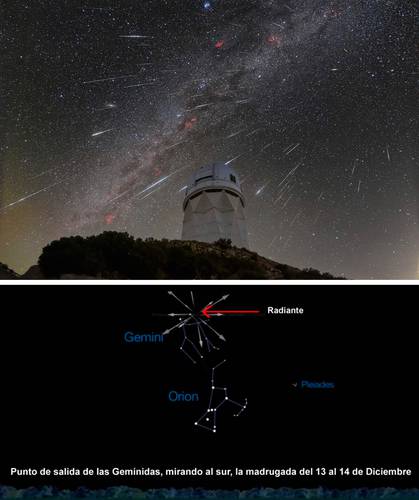The Geminids, among the few major meteor showers that come from asteroids, peaked yesterday. It’s one of the last opportunities of the year to see fireballs in the sky.
The shower often produces meteors with a distinctively yellower glow, likely due to the unusual source material, said Sally Brummel, planetarium manager at the University of Minnesota’s Bell Museum.
Under ideal viewing conditions, the Geminids typically offer one of the brightest and most dazzling shows of the year due to the high volume of meteors visible every hour. However, a nearly full moon this year means up to 120 meteors per hour are expected at peak time, according to the American Meteorological Society. the light of the moon will hide many of them
Brummel noted.
This is the Geminid meteor shower, which reached its peak on December 13 and 14, and we will be able to observe one per minute, in good visibility conditions.
said Bill Cooke of NASA’s Meteor Environment Office. The observation lasts until December 21.
Multiple meteor showers occur annually and you don’t need special equipment to see them; most come from comet debris, but some, including the Geminids, result from asteroid debris. These emanate from the asteroid 3200 Phaethon, which orbits the Sun.
During observations by NASA’s STERO space probe from 2009 to 2012, a small tail was detected protruding from behind the rock. The tail provides irrefutable evidence that Phaeton ejects dust
explained David Jewitt, an astronomer at the University of California, UCLA.
Jewitt’s team believes the dust is ejected by thermal fracturing of the asteroid’s crust. A related process, called desiccation fracture
(such as when mud cracks on a dry lake bed), can also play an important role. Seeing that 3200 Phaethon produces a tail, even a small one, gives researchers confidence that it is truly the origin of the Geminids.
When rocks from space enter Earth’s atmosphere, the air resistance makes them very hot. This causes the air to glow around them and briefly leaves a fiery tail behind them, the end of a shooting star
.
Dark, cloudless skies
Pockets of bright air around fast-moving space rocks, which range from the size of a dust particle to a boulder, can be visible in the night sky.
The rocky nature of asteroid debris makes the Geminids especially prone to producing fireballs, said NASA’s William Cooke. Those are pretty tough rocks that can penetrate deep into the atmosphere.
he added.
Meteor showers are typically most visible between midnight and the hours before dawn.
It’s easier to see shooting stars under dark skies, away from city lights. Meteor showers also appear brighter on cloudless nights when the Moon is in its waning phase. The next meteor shower, the Ursids, will peak on December 22.
